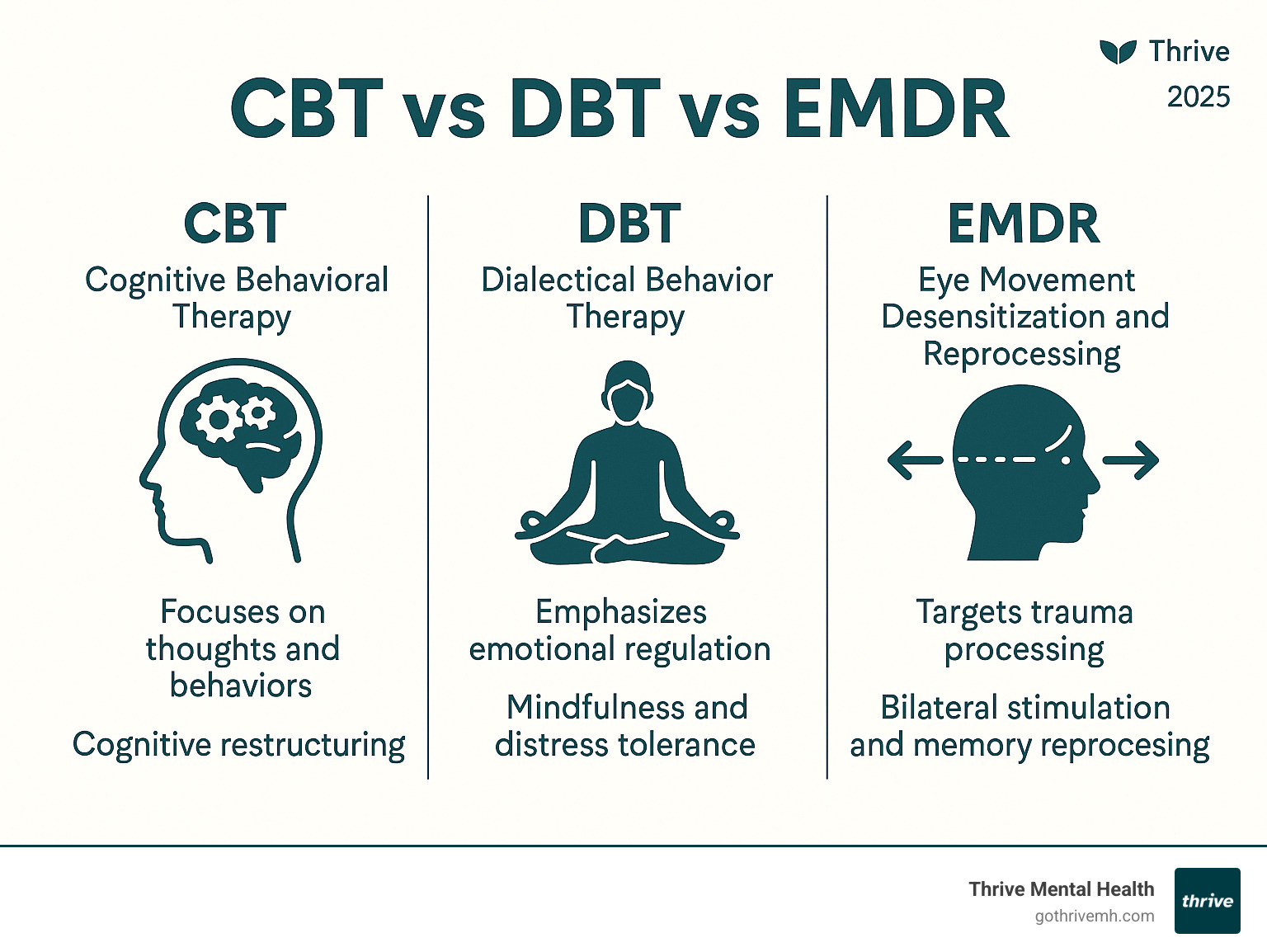CBT vs DBT vs EMDR: Which Therapy Wins Your Mind Over?

Navigating the World of Therapy Options
CBT vs DBT vs EMDR represents three of the most effective, evidence-based therapies available today, each designed to address different aspects of mental health challenges. While Cognitive Behavioral Therapy (CBT) focuses on changing negative thought patterns, Dialectical Behavior Therapy (DBT) teaches emotional regulation skills, and Eye Movement Desensitization and Reprocessing (EMDR) helps process traumatic memories.
Quick Comparison:
- CBT (Cognitive Behavioral Therapy): Best for anxiety, depression, and negative thinking patterns
- DBT (Dialectical Behavior Therapy): Ideal for intense emotions, relationship issues, and self-destructive behaviors
- EMDR (Eye Movement Desensitization and Reprocessing): Most effective for trauma, PTSD, and disturbing memories
The mental health field can feel like navigating an “alphabet soup” of treatment options. With over half of people experiencing trauma during their lifetime and countless others struggling with anxiety and depression, understanding these three powerhouse therapies becomes crucial for making informed decisions about your care.
As a busy professional, you’re likely seeking flexible, evidence-based treatment that fits your demanding schedule. The good news? Research consistently shows that CBT typically requires only 5-20 sessions, while studies demonstrate EMDR can significantly outperform traditional approaches for anxiety treatment. DBT, though more intensive, provides life-changing skills for emotional regulation.
I’m Nate Raine, CEO of Thrive Mental Health, where I’ve dedicated my career to making evidence-based therapies like CBT vs DBT vs EMDR accessible through innovative virtual care programs. My experience leading behavioral health initiatives, particularly for busy professionals in communities like Tampa Bay and across Florida, has shown me how the right therapeutic approach can transform lives when matched to individual needs.

Decoding the ‘Alphabet Soup’: What Are CBT, DBT, and EMDR?
The world of therapy can feel overwhelming with all its acronyms and technical terms. But here’s the thing—understanding CBT vs DBT vs EMDR doesn’t have to be complicated. Think of each approach as having its own personality and specialty, like different tools in a toolbox that are perfect for specific jobs.
Cognitive Behavioral Therapy (CBT): The Blueprint for Your Thoughts
Picture this: you’re having a terrible day because you’re convinced everyone at work thinks you’re incompetent. That spiral of negative thinking? That’s exactly what Cognitive Behavioral Therapy (CBT) was designed to tackle.

Developed by Dr. Aaron Beck in the 1960s, CBT works like a detective story where you’re both the detective and the mystery. It’s built on a simple but powerful idea: our thoughts, feelings, and behaviors are all connected like pieces of a puzzle. Change one piece, and the whole picture shifts.
CBT helps you spot those sneaky cognitive distortions—basically, your brain’s way of playing tricks on you. You know that voice that says “I always mess things up” or “Nothing ever goes right for me”? CBT teaches you to challenge those thoughts with evidence and logic.
The beauty of CBT lies in its structure. Your therapist becomes like a skilled coach, giving you homework assignments that aren’t boring busywork but practical exercises. You might track your thoughts in a journal, try new behaviors, or practice cognitive restructuring techniques. It’s like learning to be your own therapist.
What makes CBT particularly appealing is its efficiency. Most people see significant improvements within 5-20 sessions—perfect for busy professionals who want effective results without endless therapy appointments. The structured sessions give you concrete tools you can use long after therapy ends.
For a deeper dive into this foundational approach, check out our guide on Exploring the Basics of Cognitive Behavioral Therapy (CBT). The research backing CBT is impressive—the APA research on CBT effectiveness shows just how powerful this approach can be.
Dialectical Behavior Therapy (DBT): The Toolkit for Emotional Mastery
If CBT is like learning to think differently, Dialectical Behavior Therapy (DBT) is like getting a master class in emotional intelligence. Created by Dr. Marsha Linehan in the late 1980s, DBT was originally designed for people with borderline personality disorder (BPD), but it’s become a game-changer for anyone who feels overwhelmed by intense emotions.
Here’s what makes DBT special: it accepts the concept of dialectics—the idea that two opposite things can be true at the same time. You can accept yourself exactly as you are and want to change. You can validate someone’s feelings and disagree with their actions. This both/and thinking is transformative for people who tend to see the world in black and white.
DBT is incredibly skills-based, teaching you four core life skills that honestly, we all should have learned growing up. Mindfulness helps you stay present instead of getting lost in anxiety about the future or regret about the past. Distress tolerance gives you ways to survive crisis moments without making things worse. Emotion regulation teaches you to understand and manage intense feelings. Interpersonal effectiveness helps you communicate your needs while maintaining relationships.
What sets DBT apart is its comprehensive approach. You’re not just talking through problems—you’re actively learning and practicing new skills. Many DBT programs include both individual therapy and group therapy components, creating a supportive community of people learning together.
The validation and acceptance piece of DBT is profound. It starts with the assumption that you’re doing the best you can with the skills you have right now, and that everyone can learn more effective skills. This compassionate foundation makes change feel possible rather than overwhelming.
Want to learn more about how these skills can transform your daily life? Our article on How Dialectical Behavior Therapy (DBT) Can Improve Mental Health breaks down exactly how this approach works.
Eye Movement Desensitization and Reprocessing (EMDR): The Path to Healing Trauma
Eye Movement Desensitization and Reprocessing (EMDR) might sound like science fiction, but it’s actually one of the most effective treatments for trauma we have. Finded somewhat by accident by Dr. Francine Shapiro in the late 1980s, EMDR has revolutionized how we treat post-traumatic stress disorder (PTSD) and trauma-related conditions.

Think of trauma as a memory that got “stuck” in your brain’s filing system. Instead of being properly stored away as a completed experience, it stays active, triggering intense emotions and body sensations as if the trauma is happening right now. EMDR helps your brain finally file that memory where it belongs.
The process uses bilateral stimulation—usually guided eye movements, but sometimes sounds or tapping—while you recall the traumatic memory. It sounds simple, but it’s incredibly powerful. This bilateral stimulation seems to help your brain process the memory the way it naturally would during REM sleep.
What many people love about EMDR is that it’s less talk-intensive than traditional therapy. You don’t have to tell your story over and over again or analyze every detail. The eight-phase approach guides you through preparation, reprocessing traumatic memories, and integration in a structured but gentle way.
EMDR can work remarkably quickly for some people. That memory that used to send you into a panic might become something you can remember without the overwhelming emotional charge. You don’t forget what happened—you just stop reliving it.
For more detailed information about this innovative approach, explore our comprehensive guide on Exploring EMDR Therapy Techniques for Trauma Recovery. The VA information on EMDR for PTSD also provides excellent research-backed insights into its effectiveness.
Now that you understand what makes each of these therapies unique, let’s dive deeper into how they compare and which might be the best fit for your specific needs.
The Ultimate Showdown: A Deep Dive into CBT vs DBT vs EMDR
Now that we’ve met each therapy individually, let’s bring them together for a comprehensive comparison. Think of this as getting to know three different friends—each has their own personality, strengths, and ways of helping you through tough times. Understanding how CBT vs DBT vs EMDR differ (and where they overlap) will help you make the most informed choice for your mental health journey.
Core Differences in Approach and Techniques
The beauty of these three therapies lies in their distinct approaches to healing. While they all aim to improve your mental health, they take very different paths to get there.
CBT focuses squarely on your thoughts and behaviors, acting like a skilled detective helping you uncover unhelpful thinking patterns. It’s highly talk-based, with structured conversations that feel purposeful and directed. Your therapist becomes an active coach, guiding you through cognitive restructuring and behavioral experiments. The approach is quite structured, with clear goals for each session and regular homework assignments—think thought records or practicing new behaviors between sessions.
DBT shifts the spotlight to intense emotions and relationships. This skills-based approach is like attending an intensive life skills workshop. You’ll spend time in individual therapy, group skills training, and have access to phone coaching when you need support in real-time. Your therapist balances validation with gentle pushes toward change, accepting where you are while helping you grow. The structure is comprehensive and typically requires a longer commitment—often six months to a year or more.
EMDR takes a completely different route, focusing directly on traumatic memories. This body-based approach is less about talking through trauma and more about letting your brain do what it naturally wants to do—process and heal. Your therapist acts as a skilled facilitator, guiding the bilateral stimulation while your mind does the heavy lifting. Sessions follow an eight-phase protocol, but there’s generally less formal homework compared to CBT or DBT.
The duration varies significantly across these approaches. CBT often shows results in 5-20 sessions for many conditions, making it an attractive option for those seeking shorter-term therapy. EMDR can work remarkably quickly for single-incident trauma—sometimes just a few sessions—though complex trauma may require more time. DBT, given its comprehensive nature, typically involves the longest commitment but provides the most extensive skill-building foundation.
Key Similarities: The Common Ground of Healing
Despite their different approaches, these three therapies share some fundamental qualities that make them standouts in the mental health field. They’re all goal-oriented, meaning you’re not just talking aimlessly—you’re working toward specific, measurable improvements in your life.
Perhaps most importantly, all three are evidence-based practices. This isn’t just therapeutic jargon—it means each approach has undergone rigorous scientific testing and consistently proven effective. When you choose any of these therapies, you’re choosing treatments backed by solid research, not just good intentions.
They all emphasize a collaborative therapeutic relationship. Whether your therapist is coaching you through thought challenges, teaching you distress tolerance skills, or facilitating memory reprocessing, you’re partners in the healing process. This collaboration empowers you with new skills, insights, and perspectives that extend far beyond your therapy sessions.
Interestingly, while EMDR directly addresses past trauma, all three therapies are ultimately focused on improving your present-day life. Even when processing old memories, the goal is reducing their current impact on your daily experiences and relationships.
Each therapy aims to make you more resilient and self-sufficient, equipping you with tools you can use long after your sessions end. For a broader understanding of therapeutic approaches, explore our Guide to Common Types of Therapy and Their Uses.
Comparing CBT vs DBT vs EMDR at a Glance
To help you steer the CBT vs DBT vs EMDR decision, here’s a clear side-by-side comparison:
| Feature | Cognitive Behavioral Therapy (CBT) | Dialectical Behavior Therapy (DBT) | Eye Movement Desensitization and Reprocessing (EMDR) |
|---|---|---|---|
| Primary Focus | Thoughts, beliefs, and behaviors | Intense emotions, interpersonal relationships, and self-destructive behaviors | Traumatic memories and their associated distress |
| Best For | Anxiety disorders, depression, phobias, OCD, specific behavioral issues, insomnia, chronic pain | Borderline Personality Disorder (BPD), chronic suicidal ideation, self-harm, eating disorders, substance use disorders, severe emotional dysregulation, relationship challenges | Post-Traumatic Stress Disorder (PTSD), trauma-related anxiety, phobias, grief, and other disturbing memories |
| Key Techniques | Cognitive restructuring, behavioral activation, exposure therapy, thought records, homework | Mindfulness, distress tolerance, emotion regulation, interpersonal effectiveness skills, validation, phone coaching | Bilateral stimulation (eye movements, tapping, tones), memory reprocessing, resource installation |
| Session Structure | Structured, collaborative, problem-focused; often individual sessions | Individual therapy, weekly skills training group, phone coaching, consultation team | Eight-phase protocol, guided by therapist; less verbal processing during reprocessing phase |
| Typical Duration | Short-term (5-20 sessions for many conditions) | Long-term (6 months to 1+ year for comprehensive program) | Short-to-medium term (can be rapid for single trauma, longer for complex trauma) |
How to Choose the Right Therapy for Your Needs
Choosing the “right” therapy can feel a bit like standing at a crossroads, wondering which path to take, especially when you’re navigating mental health challenges. It’s not about finding a magic bullet, but rather aligning the therapeutic approach with your unique needs, preferences, and goals. Think of it like picking the perfect tool for a specific job; you wouldn’t use a hammer to cut wood, just as you wouldn’t use every therapy for every situation.

This important decision often involves a combination of self-assessment and consulting with a trusted mental health professional. Take a moment to consider your specific struggles, how they show up in your daily life, and what you truly hope to achieve through therapy. Do you prefer a highly structured approach, or something more flexible? Are you comfortable with “homework” assignments, or do you prefer to focus solely during your sessions? Our compassionate team at Thrive Mental Health, serving Tampa Bay, St. Petersburg, and clients across Florida, can help you find a qualified therapist who specializes in these modalities. We’re here to help you confidently steer this crossroads.
For more general guidance, you can explore our comprehensive guide on Understanding the Different Types of Mental Health Therapy.
When to Consider CBT for Your Mental Health
CBT is a truly versatile and widely applicable therapy, often serving as an excellent starting point for many individuals. You might find CBT to be a wonderful fit if you’re experiencing:
- Anxiety Disorders: Including generalized anxiety disorder (GAD), panic disorder, social anxiety, and various phobias. CBT is fantastic at helping you challenge those “what if” thoughts and gradually face situations that make you anxious.
- Depression: By identifying and gently reshaping negative thought patterns that contribute to a low mood and feelings of hopelessness.
- Obsessive-Compulsive Disorder (OCD): Through specific techniques like exposure and response prevention, CBT can help you break free from compulsive cycles.
- Post-Traumatic Stress Disorder (PTSD): While other therapies might be a primary choice, a specialized form called Trauma-Focused CBT can also be very effective for PTSD.
- Insomnia and Chronic Pain: By addressing the thoughts and behaviors that might be keeping these challenging conditions in place.
- Specific Stressors or Life Transitions: When you need practical, actionable tools to manage daily stress, improve communication, or steer big changes in your life.
CBT is especially well-suited for those who appreciate a structured, logical approach and are motivated to engage in practical exercises and apply what they learn. It truly empowers you with a toolbox of concrete strategies you can use independently, long after your therapy sessions conclude.
When DBT Might Be a Better Fit for You
DBT truly shines in situations where intense emotional regulation is a primary concern. You might find DBT to be a better fit if you often:
- Struggle with Intense Emotions: Experiencing feelings that feel overwhelming, rapidly shifting, or incredibly difficult to control, sometimes feeling like a “category 5” storm.
- Engage in Self-Harm Behaviors or Chronic Suicidal Ideation: DBT was specifically designed to address these life-threatening behaviors and provide safe, effective alternatives for coping.
- Have Chaotic or Unstable Relationships: Finding it hard to maintain healthy boundaries, communicate effectively, or steer interpersonal conflicts without things escalating.
- Are Diagnosed with Borderline Personality Disorder (BPD): DBT is considered the “gold standard” treatment for BPD due to its comprehensive and skill-based approach.
- Have Found CBT Less Effective: If traditional CBT hasn’t fully addressed your emotional intensity or self-destructive patterns, DBT’s comprehensive skills-based approach might offer that crucial missing piece.
- Need a Balance of Acceptance and Change: DBT’s unique “dialectical” approach helps you accept your current reality while simultaneously pushing you towards necessary, positive changes.
DBT’s emphasis on mindfulness, distress tolerance, emotion regulation, and interpersonal effectiveness provides a robust framework for truly building a “life worth living.” Learn more about its transformative power by exploring our DBT treatment programs.
Is EMDR the Right Choice for Your cbt vs dbt vs emdr Decision?
EMDR is a highly specialized and incredibly powerful therapy, making it an excellent choice when trauma is a central issue in your life. You might consider EMDR if you have:
- A History of Significant Trauma or PTSD: Whether from a “big T” trauma (like combat, assault, or a natural disaster) or “little t” traumas (such as chronic bullying, emotional abuse, or significant loss) that continue to cause distress.
- Feel “Stuck” in Past Events: Finding yourself repeatedly reliving distressing memories, experiencing nightmares, or having sudden, vivid flashbacks that pull you back into the past.
- Physical Symptoms of Stress Related to Trauma: Such as chronic tension, feeling constantly on edge (hypervigilance), or that persistent “fight or flight” sensation in your body.
- Difficulty Talking About Traumatic Experiences: EMDR’s less verbal approach to reprocessing can be invaluable for those who find it too overwhelming or painful to extensively discuss their trauma out loud.
- A Desire to Process Memories Without Extensive Verbal Detail: EMDR allows your brain to heal and integrate distressing memories without you needing to provide a detailed, step-by-step narrative of the traumatic event, which can be a huge relief for many.
Studies consistently show that EMDR can significantly outperform other approaches in easing anxiety issues, especially when that anxiety is linked to specific incidents or persistent stressors. It truly helps to organize the “cluttered desk” of traumatic memories, leading to a clearer, calmer mind. Explore how our EMDR therapy services can help reduce PTSD symptoms and boost mental health.
Are These Therapies Evidence-Based and Can They Be Combined?
When it comes to mental health treatment, you want to know that what you’re investing your time and energy in actually works. That’s where evidence-based practice comes into play—a fancy term that simply means a therapy has been put through the scientific wringer and proven effective through rigorous research studies.
The good news? All three approaches in our CBT vs DBT vs EMDR comparison have rock-solid scientific backing. This isn’t just theoretical feel-good therapy—these are treatments with proven track records of helping real people overcome real challenges. Evidence-based treatment means you can feel confident that your therapy choice is grounded in science, not just good intentions.
CBT leads the pack with over 2,000 clinical trials supporting its effectiveness across a wide range of conditions. DBT has been rigorously tested since its first randomized controlled trial in 1991, consistently showing remarkable results, especially for borderline personality disorder and emotional regulation challenges. EMDR has been validated through extensive research since 1989, with studies consistently demonstrating its power in trauma treatment.
But here’s where things get really interesting—these therapies don’t have to work in isolation. Think of them as tools in a comprehensive toolkit rather than competing solutions. Many skilled therapists can blend these approaches to create a treatment plan that’s perfectly custom to your unique needs.
Using DBT skills to stabilize before EMDR is a common and highly effective combination. If you’re dealing with intense emotions or self-harm behaviors, your therapist might first help you build solid coping skills through DBT before diving into trauma processing with EMDR. This ensures you have the emotional stability to handle whatever comes up during memory reprocessing.
Combining CBT and DBT for complex conditions can be incredibly powerful. Imagine you’re struggling with both panic attacks and explosive anger—CBT’s structured approach to anxiety combined with DBT’s emotion regulation skills creates a comprehensive solution. Pilot studies show that these blended protocols can improve emotion-regulation scores 45% faster than single-modality care.
The beauty of working with therapists who have expertise in multiple modalities is that they can adapt and integrate techniques as your needs evolve. Your treatment might start with CBT to address negative thought patterns, then incorporate EMDR to process an underlying trauma that’s fueling your anxiety, all while using DBT skills to manage any intense emotions that arise along the way.
This integrated approach recognizes that mental health challenges rarely fit into neat categories. By combining the strengths of different evidence-based therapies, you get more holistic and lasting healing. At Thrive Mental Health, our Florida-based clinicians specialize in this kind of flexible, expert-led care. Explore our treatment modalities to see how we can create a custom plan for you.
Conclusion: Taking the Next Step in Your Mental Health Journey
Well, we’ve certainly covered a lot of ground today! Navigating mental health therapies can feel a bit like learning a new language, but we hope our deep dive into CBT vs DBT vs EMDR has helped clear the fog. We’ve seen how CBT offers a structured path to reshape our thoughts and behaviors, how DBT provides a comprehensive toolkit for mastering intense emotions and improving relationships, and how EMDR offers a unique and powerful way to process and heal from the lingering effects of traumatic memories. Each of these therapies is a robust, evidence-based practice, meaning they’re backed by science and have a proven track record of helping people move towards mental wellness.
Your journey to healing is deeply personal. There’s truly no “one-size-fits-all” answer when it comes to therapy, and the “best” approach is always the one that aligns perfectly with your unique needs, experiences, and goals. At Thrive Mental Health, we firmly believe in empowering you with this kind of knowledge. We’re here to provide flexible, expert-led, and evidence-based care that’s custom-custom just for you.
Whether you’re struggling with the weight of anxiety or depression, struggling with past trauma, or navigating intense emotional challenges, please know there’s a therapeutic path that can help you not just cope, but truly thrive. We offer both virtual and in-person intensive outpatient (IOP) and partial hospitalization (PHP) programs for adults and young professionals across Florida, including our welcoming communities in Tampa Bay and St. Petersburg. Our team of experienced clinicians specializes in these powerful modalities and many others, ensuring you receive the most effective support possible.
Taking that first step towards seeking help is a courageous act, and it’s often the most challenging part. But it’s also the most important. We’re committed to helping you find your path to a brighter, more fulfilling future.
Ready to explore your options? We invite you to learn more about our comprehensive approach. Explore our evidence-based treatment modalities and take that empowered step forward.